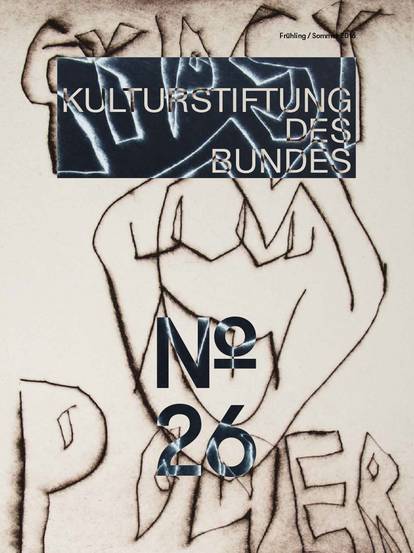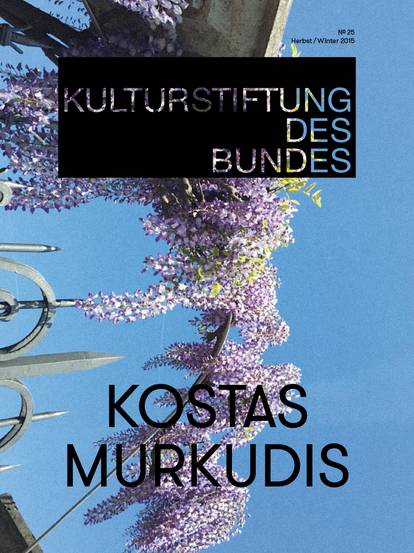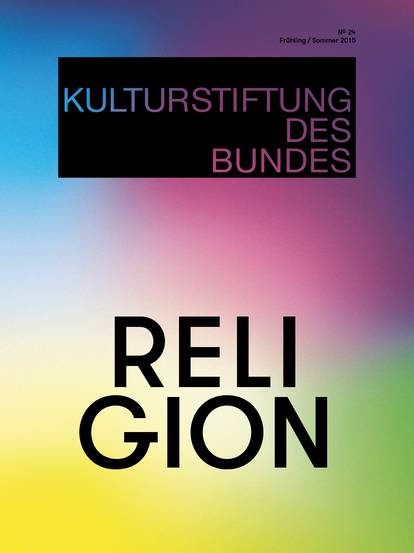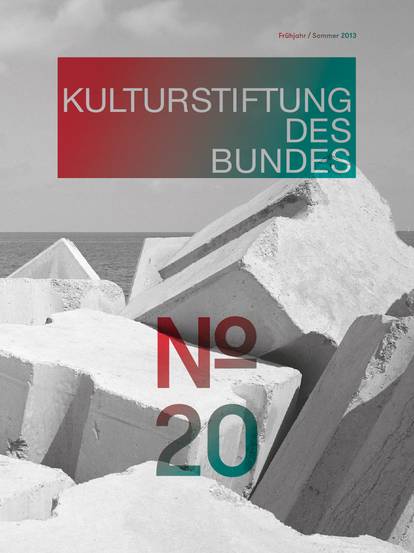The Federal Cultural Foundation has funded each Berlin Biennial, one of Germany’s cultural beacons, with 2.5 million euros since 2004. The Berlin Biennial is the forum of contemporary art presented every two years at locations throughout Berlin. A new curator is chosen for every festival and is responsible for initiating an artistic dialogue between the city of Berlin, German and international artists who live and work there and theatre audiences. The Polish artist Artur Żmijewski was selected as curator for the 7th Berlin Biennial, assisted by the associate curator Joanna Warsza, who is also from Poland. In the following interview, Warsza asks Żmijewski for his perspective on the relationship between art and politics – a subject that not only plays an important role in his work, but also in his view of himself as an artist.
An interview with Artur Żmijewski by Joanna Warsza
Joanna Warsza: You’re the kind of artist who doesn’t only care about himself, but also looks out for other artists and the art scene in general. You publish interviews with artists, you’re the artistic director of the magazine Krytyka Polityczna and now you’re the curator of the 7th Berlin Biennial. What are your guiding principles?
Artur Żmijewski: I’ve always been more interested in the social or political dimension of art and the impact of artistic work. I’ve asked myself whether the language of art is capable of getting people religiously or politically agitated. Could artists gain the same manipulative skills as politicians? How do you exert influence on people’s actions? Artistic action must have a performative character, which means it has to interact with reality, and reality must react, change and become an active part of the process.
Warsza: What does career mean to you?
Żmijewski: Career means improving yourself professionally. You move forward, acquire knowledge and skills.
Warsza: That’s a very idealistic definition.
Żmijewski: But that’s the correct definition of the word. There’s the greatness of art and there’s poverty in society – and some artists possess skills that are truly astounding.
Warsza: You’ve been chosen as curator of the Berlin Biennial, because your art is driven by ideals.
Żmijewski: The privileges, benefits or authority that a person could gain from such a position are beyond me. I guess I’m kind of autistic or sociopathic in that way. I’m just not able to cultivate networks or comprehend social hierarchies and power structures. Some people might think it’s a matter of being introverted or socially incompetent. In the meantime, I’ve come to understand the necessary rituals and etiquette. Sometimes you have to force yourself through tedious discussions in order to build social bonds. My autistic trait is my fixation on ideals. I don’t mean to say that I’m totally free of artistic narcissism – I’m also driven by that. I, too, enjoy seeing my name mentioned somewhere. The need for attention is an important mainspring. You just have to channel it so that you can use it for political purposes – for example – instead of securing privileges. As curator of the Berlin Biennial, I have the feeling that I’ve been granted a certain amount of power, but this power is ephemeral and only symbolic. Compared to political power, it’s actually rather limited. The Berlin Biennale is a difficult exercise in delegating power – it’s like film. Filmmaking is about team work – you need the knowledge and skills of many people: camera, sound, editing. I could have a magnificent idea, but if I don’t incorporate the skills of all these people, I can’t make a film.
Warsza: Why do you think artists no longer sacrifice themselves for their ideals, and prefer instead to promote their own careers?
Żmijewski: The longest, most significant tradition in art is conformism, not resistance. Assimilation and declarations of loyalty comprise the mainstream. What we think is the most important thing in art – namely resistance, non-conformism, challenging the norm – these are just flashes on the fringe. Today, art is used as a tool to help people conform, to ensure that certain rules are followed. One rule, for example, is that in the art scene, artists are supposed to sympathetically converse in “leftist” terms about social misery. We always assume that artists want to help people and that a curator wants nothing more than absolute freedom of opinion. But this language glosses over political divisions and is little more than conformism. Some time ago, I read a report about an art fair where artists and galleries presented numerous interesting works which drew attention to social misery. I thought, what would happen if you changed the sentence to read: “At the art fair, people came together who actively support capitalism and hope to profit from commercializing social misery.” That is the underlying obscenity of art, just as extreme right sympathies or neoliberal positions are obscenities that underlie artistic do-good terminology. Or as obscene as the opportunism of allegedly rebellious or provocative artists.
Warsza: Then ‘true art’ is the exception?
Żmijewski: The Dutch artist Renzo Martens claims that artists are able to make utopias a reality, they can create something extraordinary, conjure up a situation which, for instance, could do away with the mechanisms of suppression in the capitalistic economy or dispel social constraints. Instead of an economy of profit-taking, an economy of giving would suddenly predominate, ushering in an unlimited, non-destructive freedom. Artists have the ability to manufacture such situations, but they can’t transfer them to other contexts and sustain them. And that’s one of the biggest, most dangerous desires among artists – universalizing exceptions. Maybe we should look for ways to universalize them. If artists are in the position to create situations based on alternative principles which seem more attractive and liberal than our normal social coexistence, then perhaps we should try to universalize them, to disseminate them. Religion has succeeded in universalizing the divine experience. Democracy is a universalized condition of coexistence in which disputes are solved on a symbolic level that guarantees security to both conflicting parties. The possibility of safely resolving conflicts or experiencing the presence of God are universalized exceptions. That could be the political task of art – naturally not every branch of art. There have been situations when political change served as a vehicle for universalizing artistic experience. That was the case in the time of socialistic realism. Socialistic realism was a new aesthetic paradigm which, under administrative and political constraints, served as an extremely ideological means of visual communication for the masses in a time of proletarian turmoil. The local terminology and visual language were universalized and became the mainstream. This didn’t only apply to the fine arts. Poems were written back in 1930s in the style of social realism: “Czy rośnie chleb spod pługa, czy lecą skry spod młota – to nasza jest zasługa, to nasza jest robota” (“Bread grows beneath the plough, sparks fly from the hammer – this is our doing, this is our work”). Today this kind of language is anathema. Unjustly so. The Bauhaus is another example of a universalized and generally recognized aesthetic experience. In several small German schools, they produced an aesthetic exception and universalized it so successfully that a new aesthetic paradigm developed.
Warsza: But communist dictatorships also controlled art. They differentiated between true and degenerate art. Aren’t you wary of such classification?
Żmijewski: People classify art even today, only the criteria have changed. Class differences and sub-categories exist based on various levels of artistic quality. It’s not so much classification that I’m afraid of, but rather that the channels of expression are getting clogged. There’s no unity, there’s only a loose collection of particularities and localities.
Warsza: And if someone urged you to get involved in politics...
Żmijewski: That would interest me.
Warsza: If you got into politics, how could you maintain your status as an artist?
Żmijewski: I’ve no real choice because my abilities are all anchored in the arts. I don’t believe that what we call “politics” is truly politics. It’s actually a fraud, an ersatz, cultivated by the professional elite of the political bureaucracy, which has snatched politics from the hands of the citizens. The insensitivity of governments with regard to citizens’ demands for equality, emancipation and prosperity and the oversensitivity in the face of fascistic fantasies of an impoverished majority are now the rule, not the exception. Capitalism has destroyed the social solidarity between us and turned society into a group of competitive clans. In its radical form, capitalism corrupts democracies, changes them into oligarchies and conjures up dreams of plutocracies. Artists could also have an impact in this area. It’s not about maintaining one’s status as an artist, but rather making room to maneuver so that you can manipulate reality, for example, by putting leftist ideas into practice. Artists are just as capable of setting the same chain of events in motion as politicians. In order to activate their followers, artists – in contrast to politicians – use paradoxes, reveal inconsistencies, challenge the status quo or disclose secrets which give way to a whole range of new secrets. This enables them to achieve a kind of diversion or shocking revelation which influences action. The viewer is stunned by the magnitude of the secret. The media exorcisms by journalists, and now politicians as well, are the typical reaction to such artistic works. The status of the artist plays no role in such a situation – what matters is gaining operative knowledge: How do I plan my second move, how do I change the stakes on this frenzied playing field?
Warsza: Then what is politics and what is politicization?
Żmijewski: Politics is a formula of social interaction. For artists, it seems the best thing to do is to take some idea and run with it. I have the feeling that everyone in the arts, who has put their faith in an idea and felt inspired by it, triumphed in the end.
Warsza: Who, for example?
Żmijewski: Hans Haacke and all those who pursue idea-driven politics through art – they’ve come out on top and are visible. That’s also how they become proactive subjects. You can’t bestow this status on yourself – you have to achieve it through ideas which represent something bigger and stronger than yourself. Or do you think you be a subject just by being? A somebody?
Warsza: Yes, I think so.
Żmijewski: That’s an illusion.
Warsza: When you first started at the liberal-oriented magazine Krytyka Polityczna, did you immediately equate your work with an idea?
Żmijewski: Not completely. I had certainly bathed in the radiance of various leftist ideas before, but I had no names for these ideas. But after I joined Krytyka Polityczna, the guardians of the art world tried to put me in my place several times. I noticed they were trying to shackle me. I realized that artists are kept in chains so that they don’t get too close to the political fire, otherwise things could get dangerous.
Warsza: Does anybody care about artistic handicraft nowadays? We’re seeing other areas migrating into the arts – radical sociology, architecture and education all have an established place in the art world. No one seems interested in diplomas anymore because art also integrates people from outside the field.
Żmijewski: I agree, but I would also claim that art is comprised of both handicraft and knowledge of a specialized area. It’s false to think that art is a tool of the ignorant. If you use images to convey information, you have to know how an image is constructed, what graphic elements have a forceful or relaxing effect. You have to know whether you are playing with myths, stereotypes or prejudices. You have to know how things are constructed and what kind of layers are in a picture – including ideological layers. I have a very broad concept of images. I see images as a visual language with various dialects and slang. I myself used to think, “Why do we need an academy, why do we need to learn about composition and waste time with boring drawing exercises using models. Why do we need this, when in reality it’s all about ideals?” But if a picture is to convey an idea, you have to master the visual language and that is based on handicraft, on knowledge about graphic design, on understanding spatial relationships and chromatics. Of course, you don’t always need academic knowledge. Sometimes one’s intuition is enough. But you do need the grammar of visualization so that your artistic language is effective and communicative.
*
Warsza: What then is the visual grammar in the film Berek [Game of Tag], where people play tag in a gas chamber, or in your latest piece Katastrofa?
Żmijewski: In Berek, it’s the greenish-yellow marks of Zyklon B on the walls and the naked men and women playing a game of tag in a gas chamber. It plays on the dissonance of perception between that which is appropriate – the quiet, respectful behaviour in such a place – and the abrupt intervention of bodies, flushed in playful movement. The result is a feeling of almost obscene, pornographic relief. No one dies, and at the same time, the film presents an image of vital, sexual energy. Katastrofa, on the other hand, is almost purely journalistic with a slight anthropological thrust. We artists see more than journalists see, we are allowed to see more and to say more. Katastrofa is an abundance of seeing and a liberation from a single, ideologized goal. We observed what people in Poland did following the catastrophic crash of the president’s plane near Smolensk.
You mentioned that one form could be coordinating a meeting of some kind. That’s possible. In most cases, forms are indeed something external; most of the works by contemporary artists are structured like a joke. They can even be told like a joke. First there’s the set-up and at the end comes a surprising punch line. For example: Two older women, a German and Turkish lady, meet, talk, and then take off their clothes and exchange them. I’m not passing judgment on this situation, I only mean to show that it possesses the same structure as a joke. It is a self-contained, ideological unit which can stand on its own even when removed from its local context. You can show it in Berlin, or just as well in Beirut or Barcelona. You can tell it like an anecdote – and the art world is constantly telling such anecdotes. Most of them eventually become channeled into a collection of anecdotes which are told worldwide. That is a self-contained form, but I don’t want the work of an artist to end with a punch line. If it weren’t so introverted and hermetic, it could be an option for local contexts, but then again, it wouldn’t be able to defend its quality because it would be open to attack from outside. Perhaps it would be more interesting to work on artistic structures that resemble jokes without punch lines, which have any number of resolutions or even no resolution at all.
Warsza: You’ve been living in Berlin for the last six months. You once said that the seductive narcissism of the city lays claim to artists from all around the world. Then why do radical artists from Colombia or Japan come here? What are they doing here?
Żmijewski: They’ve strayed from home, cheap rents lured them here. They’ve forgotten that the only thing that makes sense is doing something for one’s own community – without that, nothing has meaning.

![[Translate to English:] Magazine 38](/fileadmin/_processed_/f/1/csm_Magazin38_Cover-Vorschau_921x1230_689f428dc3.jpg)
![[Translate to English:] Magazine 37](/fileadmin/_processed_/b/c/csm_Mag37_Cover-Vorschau_921x1230_b5129fdb2a.jpg)
![[Translate to English:] Magazine 36](/fileadmin/_processed_/2/a/csm_Cover_Magazin36__issuu_2f3cef97bb.jpg)





![[Translate to English:] Magazine 30](/fileadmin/_processed_/c/b/csm_magazin30_vorschau_9005f773d3.jpg)














